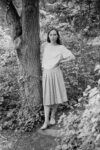Because my life has been so saturated with religion in one form or another, it is difficult for me not to be fascinated by Barbara Ehrenreich’s very atheist account, in the book of the same name, of “living with a wild god.” At least, it seems very atheist to me. Living with a Wild God is a text one might find difficult to classify; how does one categorize a book about “living with a god” that was penned by a lifelong atheist, who furthermore never explicitly renounces that identity?
 The book’s origin is curious. Looking through her collected papers for an archive, Ehrenreich came across some childhood diaries that she, knowing what they contained, was reluctant to give up. So she began transcribing them. They describe a girl, caught between a mother who seems to despises her and a father who wants her to carry his ambitions (a task he increasingly judges to be impossible, as with puberty she becomes more obviously a woman), preoccupied with what she calls “the Situation.” This is her term for not only the general state of things, but also the meaning of the world and her place in it. Her precociously analytic approach to this question, perhaps exacerbated by her home life and her isolation as the only atheist in her rural Montana school, lead her to a form of solipsism, both an answer and an impasse in her search. At the same time, however, she begins to have experiences that she describes as approximating those typically characterized as “mystical”: for example, on a family day trip, a tree “presents itself” to her as a rush of living substance.
The book’s origin is curious. Looking through her collected papers for an archive, Ehrenreich came across some childhood diaries that she, knowing what they contained, was reluctant to give up. So she began transcribing them. They describe a girl, caught between a mother who seems to despises her and a father who wants her to carry his ambitions (a task he increasingly judges to be impossible, as with puberty she becomes more obviously a woman), preoccupied with what she calls “the Situation.” This is her term for not only the general state of things, but also the meaning of the world and her place in it. Her precociously analytic approach to this question, perhaps exacerbated by her home life and her isolation as the only atheist in her rural Montana school, lead her to a form of solipsism, both an answer and an impasse in her search. At the same time, however, she begins to have experiences that she describes as approximating those typically characterized as “mystical”: for example, on a family day trip, a tree “presents itself” to her as a rush of living substance.
These episodes—which are not, as far as she can tell, the result of mental disorder (a possibility she has apparently investigated extensively)—eventually culminate in a trip to the mountains and back through a small desert town, in which the street is seen by her as if on fire, yet without burning, the world unveiling itself as pure sensation. After this, the episodes cease. The rest of the book largely consists of her attempts to make sense of these experiences. It is in these attempts that the ambivalence between atheism and faith introduces itself. Despite her seemingly supernatural encounters, Ehrenreich maintains that the god of classical theism (all-knowing, all-loving, all-powerful) is nonsense. As a teen, she briefly experiments with a form of makeshift Hinduism picked up from books, but she finds meditation impossibly difficult and ultimately gives it up. In the final chapter, she explores multiple alternative possibilities. The closest of these to an existing religion is her interest in animism; the furthest, an idiosyncratic interpretation of Meister Eckhart that seems closer to Ridley Scott’s Alien than the confessions of any Christian believer. The book concludes with a call to investigate “mystical” phenomena and the like as real facts about the world, and someone or something else that might be experienced in it, rather than merely the hiccups of a pre-critical age.
When I was growing up, my family went to church every Sunday, all six of us trundled into a car en route to the big renovated ex-Methodist church, with a drum kit and a swimming pool installed for baptisms, and plastic sound breakers affixed around the windows to keep the speakers from echoing in a building designed for preaching. As young children, our parents would regularly read Bible stories to my siblings and me and would pray with us most nights before we went to sleep—at least, if I recall correctly.
As I grew older, I became aware that, though my experience was not unique, it was not the norm among my peers. Older still, I got into lively “discussions” with my classmates. We were teenagers, with teenagers’ understandings of the world: I was a typical evangelical in miniature, and often they would rehearse the rhetoric of the New Atheists, then still very much in vogue. In hindsight, it’s easy to see just how much of that conversation was dominated by the specter of 9/11 and the highly racialized narratives that arose around it. Whole books might be written on how much Christian rhetoric Bush, Blair, and the rest appealed to for their holy war on terror, and on the perhaps not-so-ironic allegiance of the New Atheists to this crusade. One might even argue that the distinctive contribution of the New Atheism to conversations about religion and secularism was a mobilization of unbelief to help launder Western imperialism for secular culture—a godless gospel, the necessary propagation of which demanded new missionaries.
Of course, these are not the only terms on which one might engage with religious discourse. Since those classroom debates, my own attitudes to faith and its absence have shifted significantly, both in ways that are easily nameable (I converted from one tradition to another) and in ways that are not. Similarly, there are many forms of unbelief much worthier of attention than that of Dawkins et al., and the New Atheism is, in historical terms, precisely that—new. Occasionally, reading Ehrenreich, I felt as if I might be looking through a window onto the shape of American atheism before Harris and Hitchens. This was the un-faith of her forebears in Butte, Montana, all the way back to her great-grandmother, who with her dying strength threw the priest’s crucifix across the room as he attempted to administer the last rites. There is almost no sign here of the persistent fixation on violence or war that is often treated as so central in contemporary discussions of religion. The Ehrenreichs are much more concerned with empiricism, with the simplicity of living in the world that you actually experience, with religion as deception or distraction. Maybe this is not entirely worlds apart from the appeals to science by Dawkins and the like, but it is at least distinct. Is it possible that the usual (understandable) insistence that atheism is simply a product of experience or reason in some “pure” sense has led to a neglect of the shape of atheism as a tradition, with its own distinct shared principles and trajectories, yet encompassing competing strains?
Based on the marketing surrounding it, the publishers seem to have expected Living with a Wild God, which was released in 2014, to make waves, perhaps even to fundamentally shift the public discourse on atheism and religion. This wasn’t unreasonable, given the success of Ehrenreich’s previous work and her significant reputation. But this shift doesn’t seem to have materialized. Indeed, many critics seemed extremely dissatisfied by her theological turn. In his review in the New York Times, Dwight Garner wrote: “Kingsley Amis once said that religion and masturbation were alike in one regard. Feel free to practice them, that is, but no one really wants to hear you go on about it.” This might be not entirely unfair—one might recall the Biblical injunction to practice one’s faith in secret so that one’s “Father who sees in secret will reward you” (Matthew 6:4, 6, 18)—but it seems inaccurate to treat a practice of self-satisfaction as directly analogous to Ehrenreich’s attempts to identify something outside of the self and its usual points of reference. One can’t help but wonder: if Garner doesn’t want to hear about religion, why did he read the book? He has a right to his disinterest, but such apathy seems likely to obscure understanding of a matter that usually (euphemisms aside) elicits a certain amount of passion.
David Shariatmadari, writing in The Guardian, also criticized the book, this time from the opposite direction, arguing that the staunchly atheist Ehrenreich’s capacity to write about spiritual matters may have been “stunted by years of running in the other direction…. Her vistas are cold, dry, lunar: landscapes that lack much evidence of human, let alone divine, intervention.” This seems equally unfair. Most of the book is taken up by a record of her life as a teenager and a young adult, in which, by her own admission, she was heavily inclined toward solipsism. The strangeness of what she never quite firmly names as a “mystical experience” in that desolate landscape is precisely what drives the narrative.
A failure to recognize this central impulse of the book is not isolated to Ehrenreich’s critics. Hanna Rosin, writing in Slate, suggests that rather than the story of a quest for a god broken off before its climax, Ehrenreich instead presents us with the story of someone who did not spend their life in such a fruitless quest, but instead allowed that (spiritual?) energy to be directed into meaningful political work. This is perhaps not entirely wrong. It is true that on her account, it was at least partially Ehrenreich’s search for whatever it was that she experienced that day in a small desert town that led her out of her solipsism and firmly into a world populated by others.
There is, as the Catholic philosopher Falque describes, a certain relationship between the apprehension of created and uncreated others, between the “perceptive faith in the world” that provides the backdrop to “our” experience as a shared humanity, and the “religious faith” in God or a god that emerges from a specific type of experience that one might call “religious.” At the same time, Ehrenreich’s story provides a welcome correction to the singular “world” of Falque’s perceptive faith and to his “common humanity,” harmonious and un-sundered by political divisions such as class, race, and gender, that characterize the world in which we actually live. But Ehrenreich’s path is not simply a turn away from the spiritual to the political, but a passage to the political through, but without ever leaving behind, the spiritual—or perhaps vice versa. After all, it can’t be for nothing that Ehrenreich returned to her unfinished adolescent quest all these years later.
At the same time, however, it is difficult for me to separate my reading of Ehrenreich from the developments in my own approach to religion. Perhaps the book’s appeal to me not because Ehrenreich directly provides a different vantage point on atheism as a tradition, but because a key shift in my life was coming to recognize Christianity as a tradition, with all of the difficulties that entails, rather than as a simple monolith to either accept or reject. Perhaps it is not the case that Ehrenreich gives an account of a passage through the spiritual to politics, but I’m inclined to read her this way because this has been the movement that I have sought after more and more in recent years. There is a habit among some to reject such direct analogies between writer and reader, to treat eisegesis—an act of interpretation that includes or even imposes one’s own presuppositions—as an illegitimate projection onto a text that should be approached with disinterest. But does this disinterested reading really exist? At risk of repeating myself: why would you read something if you had no interest in it?
Indeed, if anything, I might argue that such eisegesis on my part indicates that the book has, at some level, succeeded. Living with a Wild God argues that certain phenomena historically excluded from atheistic discourse—or, for Ehrenreich, empirical discourse, scientific discourse—ought to be treated as legitimate areas of discussion and even factors to be taken into account in an analysis of “the Situation.” This is not an attempt to smuggle God in through the empirical backdoor, but at the same time, it does represent the potential recognition of a point of contact, a shared space, for discourses that depend on appeals to divinity and that depend upon its rejection. Even if this proves only to be a nice site in which to recommence hostilities, after years of the intellectual wasteland created by the New Atheism, that’s a meaningful battle to risk. But equally, Ehrenreich offers the possibility that our encounters may teach us as much about ourselves as they do about one another.
Jonathan Murden writes a monthly column of cultural theology. Murden is an Orthodox Christian and undergrad currently based in the north of England.
This post may contain affiliate links.







